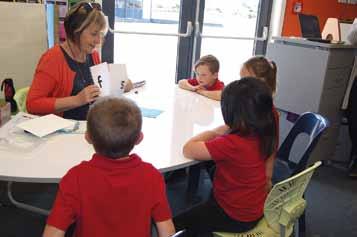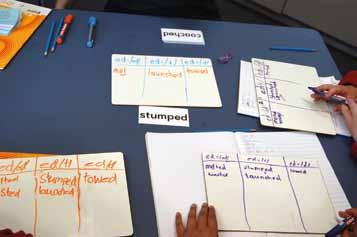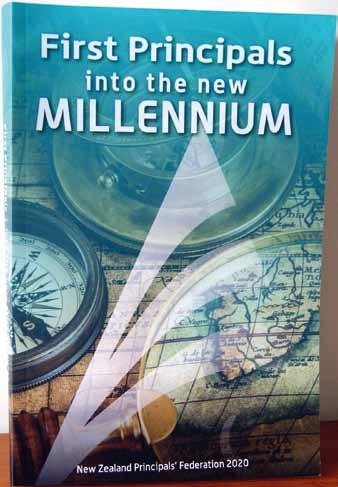
10 minute read
THe ScIeNce oF reADING
WhY do Words coUNt?
James w. chapman
ProFessor eMeritUs oF edUcatioNal PsYcholoGY, MasseY UNiversitY
mANy PrINcIPALS, TeAcHerS, Ministry of Education The advice to students in initial teacher education programmes, officials, and politicians have expressed concerns about the promoted and supported by Department/Ministry of Education literacy performance levels of New Zealand children. Our publications since at least the early 1980s, has been on the rankings in international surveys have steadily dropped over ‘multiple cues’ theory of reading. When beginning readers come the past 50 years. In 1970 the first international literacy survey across an unfamiliar word in text, they are encouraged to use of 9-year-old children was held. New Zealand was ranked 1st. cues such as pictures, the meaning or syntax, or some of the In 1991, New Zealand ranked 6th. The first in a series of rolling letters in the word. surveys, the Progress However, in International research clearly Literacy Survey shows that good (PIRLS) was held in readers have 2001; New Zealand strong word-level 9-year olds ranked skills, whereas 13th; in 2006, 22nd; poor readers 2011, 23rd; 2016, have weak word33rd. New Zealand level skills and ranked lowest of compensate English language for this lack by countries in the over-relying on latest (2016) survey. meaning cues.
What went wrong? Further, when International learners are surveys aren’t the encouraged to use be-all and end-all non-word-level measure of learning outcomes. But they The juniors learn how to put sounds together cues (e.g., picture, syntax, developing provide an important, independent source of information. meaning—if they understand the developing meaning) they Despite various government attempts to improve the literacy lose an opportunity to pay attention to the word and to map performance of our children and to reduce the big gap between it to memory. Unfortunately, the multiple cues approach good and poor readers, things have got worse, not better. disadvantages the children who need the most help in learning
The failure to improve the literacy learning outcomes of our to read. children has been attributed to poverty, increased use of digital This deeply entrenched approach to literacy instruction devices, poor parenting and home backgrounds, and poor school in New Zealand has been discredited by scientific studies of facilities. Other countries have these issues as well. Poverty and reading for nearly three decades. Extensive research shows that the use of digital devices, for example, exist in many countries, achievement in reading comprehension (reading for meaning) including the other English language countries that we now lag depends on two processes: the ability to recognise the words in behind. Virtually no policy attention has focused on our literacy text accurately and quickly, and the use of language skills such teaching methods as one of the fixable reasons for our declining as vocabulary and syntax. Progress in learning to read words performance. requires the ability to translate letters and letter patterns into
New Zealand has followed a strongly constructivist approach phonological forms (i.e., letter-sound relationships). Making to literacy education for the past 30 years. This approach is based use of letter-sound relationships provides the basis for beginning on the belief that learning to read is like learning to speak; both readers to develop sight word knowledge—for building a mental abilities are said to develop ‘naturally’. The claim is that ‘children dictionary of print words. This in turn allows beginning readers learn to read themselves; direct teaching plays only a minor role’ to use their cognitive resources to focus on sentence meaning (Smith & Elley, 1994, Learning to read in New Zealand, p.87). and text integration. This view gets to the crux of the matter, which is about the role To develop links between spelling patterns and sound patterns, of word-level information in learning to read. children have to be able to segment words into phonemic
sequences; they have to understand that spoken words and syllables are made up of sequences of speech sounds. Developing phonemic awareness (the ability to hear and manipulate the sounds in spoken words) is essential for discovering spelling-to-sound relationships and for grasping the alphabetic principle. Understanding the alphabetic principle, or ‘cracking’ the alphabetic code, is necessary (but not enough by itself) for being able to read for meaning. Put simply, children cannot get meaning from text if they cannot identify the words in text that carry the meaning!
There is now a large body of research showing that explicit, systematic instruction in relating spellings to pronunciations positively influences reading achievement, especially during the early stages of learning to read. And conversely, a lack of these skills has a negative influence on reading acquisition. Explicit children at Kaiapoi North School work on sounds through the Science of reading Approach attention in early literacy instruction to alphabetic coding skills, alongside explicit attention to vocabulary, is helpful for all children and crucial for some.
Teaching beginning readers word-level decoding skills and strategies systematically and explicitly is vital for providing children with the foundations for learning to read. Because of the entrenched approach to literacy instruction few teachers have had the opportunity to learn how to do this. It has become clear that effectively teaching reading skills to beginning readers requires that teachers have a thorough understanding of the basic structure of the English language, including an understanding of the sound-symbol correspondences of written English and how this affects reading development. Louisa Moats, in her highly acclaimed publication Teaching Reading IS Rocket Science (2020, https://www.aft.org/sites/default/files/moats.pdf), showed that relevant teacher knowledge includes understanding language and some linguistics, as well as understanding the psychology of reading development and cognitive development.
Although phonics programmes have provided teachers with some of the important language knowledge involved in reading acquisition, many haven’t had the opportunity to refresh their teaching skills in line with current research on best practice in literacy instruction. This is the case even when they know they need to change their instructional practices. Change is required if the literacy learning outcomes of all children in New Zealand are to improve.
My colleagues and I tested instructional changes in a Ministry of Education-funded longitudinal research project. We developed a teacher PLD programme that focussed on developing teachers’ levels of knowledge and the practices required for more effective literacy teaching. This year-long programme consisted of five workshops spaced over the four terms and totalled six days of workshop attendance.
To provide a conceptual guide in the workshops, we adopted the Cognitive Foundations of Learning to Read framework (Tunmer & Hoover, 2018, Australian Journal of Learning Difficulties). This framework combines the two essential components required for independent reading for meaning (reading comprehension): language comprehension and word recognition. It’s necessary that both word recognition and language comprehension are taught in an integrated manner in each literacy lesson. The weighting of the instructional focus on either word recognition or language comprehension differs,
based on the learner’s current needs. Beginning readers, for

And another new word is sounded out

example, require focused instruction in word recognition, and all that it involves, with language comprehension taught in wholeclass settings. Learners with greater word recognition knowledge have focused instruction on language comprehension, and less weighting on word recognition, because they have the foundation skills required for independently accessing written words.
One major aspect of the PLD programme was the provision of strategies for teaching the necessary knowledge and skills. This revolved around the use of explicit, structured, and systematic instruction. Explicit instruction does not leave acquisition of essential knowledge to chance in the hopes that children will ‘get it’. Instead, explicit instruction requires breaking down the necessary learning into key components. These components include each letter name and sound, blending of phonemes together to decode unfamiliar words, segmenting sounds in spoken words to spell unknown words, as well as teaching the meanings of target words. To assist teachers with this process in working with children, we provided or recommended the use of decodable readers. In contrast to the current Ready to Read texts which are based on predictable text to facilitate meaning, decodable texts provide children with the opportunity to practice their word-level decoding skills and strategies. Importantly, teachers and children enjoyed the decodable texts.
To examine the effectiveness of the PLD workshops, the new entrant teachers who participated in these sessions formed the ‘intervention’ group. New entrant teachers in other schools opted to form the ‘comparison’ group. The new entrant children in both groups all started school for the first time following the Christmas holiday break, and they had similar scores across a range of reading-related measures.
By the middle of Year 2, the intervention children significantly outperformed the comparison children on assessments of reading and spelling. Especially significant was the finding that low decile intervention children on average markedly outperformed the low decile comparison group of children. On some measures, the low decile intervention children had mean scores that were close to or equal to those of children in higher decile schools.
Assessments of the intervention teachers showed important improvements in their knowledge of the language foundations associated with effective literacy teaching and learning. Video clips of classroom teaching also revealed changes in instructional practices that reflected the content and materials from the PLD workshops. The significant improvements in literacy learning outcomes of the intervention children are consistent with the The young students have a think about this sound changes teachers made as a result of the PLD workshops.
Our approach for teaching early literacy combined wholeclass instruction with small-group instruction for reading and spelling. Whole-class teaching provided instruction in oral vocabulary and concepts about print using picture books and big books. Small group reading and spelling teaching combined phonics instruction with the reading of connected text and with learning to spell words. The small group teaching is based on the use of an instructional scope and sequence and targeted assessments to ensure children receive specific instruction to meet their strengths and needs. Both small-group and wholeclass teaching involved explicit explanations but differed in the instructional strategies immediately following the explicit explanations.
A full technical report and a shorter easier-to-read report with specific teaching guides are available on the Education Counts website: https://www.educationcounts.govt.nz/publications/ schooling/early-literacy-research-project
The findings from this project are consistent with other similar projects in a range of countries. The research is not a one-off or an outlier. It is part of the mainstream of scientific research on reading. Evidence of the importance of providing explicit and systematic instruction on the development of word-level decoding skills and strategies has emerged in the research literature for over three decades now. And nation-wide evidence of the value of the approach can be seen in the 2016 PIRLS results for England. Following the introduction of a stronger ‘phonics’ approach to teaching after a major report on the teaching of reading in the mid-2000s, children’s scores on the 2016 PIRLS literacy assessments showed a significant improvement.
Many schools in New Zealand are now working to implement a structured approach to teaching literacy. These schools have invested in training or have participated in projects like Teaching to Ensure Progress in Literacy (https://gazette.education.govt.nz/ articles/phonics-based-literacy-inquiry-lifts-progress), or the Better Start Literacy Approach (https://www.betterstartapproach. com/). The participating teachers in these projects are finding considerable improvements in student literacy outcomes and in student motivation to engage in literacy tasks.
The take-away message? Do the same thing; get the same results. The status quo especially disadvantages Māori and Pacific children, and children in low decile schools. That is simply unacceptable, especially when we know that it doesn’t have to

be that way. Teaching children to develop effective word-level
older children learn more complex blends and sounds to decode words decoding skills and strategies, explicitly and systematically, is far more effective than leaving the development of word knowledge to chance. Words count.

FurTHer reADING
Chapman, J.W., et al. (2018). Teachers’ use of phonics, knowledge of language constructs, and preferred word identification prompts in relation to beginning readers. Australian Journal of Learning Difficulties, 23, 87-104.
Hoover, W.A., & Tunmer, W.E. (2020). The simple view of reading: A useful way to think about reading and learning to read. The Reading League Journal, May-June, pp.35-40.
Tunmer, W.E., & Chapman, J.W. (Eds.) (2015). Excellence and equity in literacy education: The case of New Zealand. Basingstoke, England: Palgrave Macmillan.
AbouT THe AuTHor Professor James Chapman is an international researcher recognised for his work in the areas of cognitive-motivational factors associated with learning disabilities and the development and remediation of reading difficulties. He has published over 150 journal articles, book chapters and books on learning disabilities, special education, literacy learning difficulties, early literacy development, reading intervention, and selfsystem factors in academic achievement. In 1999 he was co-winner of the International Reading Association’s Dina Feitelson Award for Excellence in Research. Professor Chapman was head of the College of Education at Massey University for 10 years. Contact email: j.chapman@massey.ac.nz





